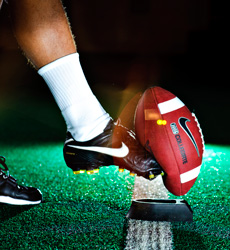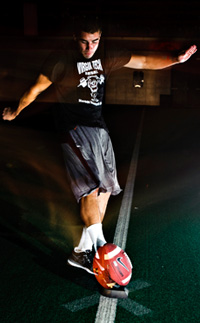 |
|
||||||
|
|
||||||||||||||||||||||||||||||||||||||||||||||||||||||||||||||||||||||||||||||||||||||
|
The inner workings of Virginia Tech
by JESSE TUEL
1) Plenty of physics lessons pass through the football on game day. We see the ball take flight, en route toward one, three, or six points, but that's not the only math going on. Get this: at the moment of impact, starting kicker Justin Myer's foot causes the football to deform inward--even with his usual soccer-style kick. For the sake of illustration, Myer kicked a few fully inflated balls with his toe. 2) The impact causes waves to traverse the ball's warped membrane like a sound vibration. Points on the surface are "pulled back and forth by their own neighbors," said John Simonetti, a professor in the physics department. "That's what a wave is about, [and it] will get transmitted all around." Still, the initial waves are irrelevant to the direction of flight. "Those forces add up to nothing." 3) Newton's third law of motion--equal and opposite reactions to any force--dictates that the ball pushes back on the foot with equal force, Simonetti said. But the foot, carrying the mass of the body's momentum, wins out, imparting a vector that causes acceleration and rotation. 4) Inside the ball, air molecules respond to rotation in about 0.5 milliseconds, Simonetti said. The molecules flit about anyway, bouncing off opposing walls at the rate of about 340 meters per second. Given the Nike 3005's circumference of 56 centimeters perpendicular to the laces, the molecules swiftly apply the ball's in-flight rotation to their otherwise random freneticism. 5) Outside the ball, other forces are in play. The backspin on a kicked ball, tumbling end over end, produces a measure of lift. The top surface of the ball moves away from the direction of flight, creating a velocity between the air and the ball's surface that is less than the velocity influencing the bottom plane of the ball. Were the spin reversed, it would generate downward force. 6) Any Monday-morning quarterback will tell you the spiral pass is more aerodynamic than a ball tumbling end over end. But it's not quite perfect. The ball's laces cause a disturbance in the air, creating a destabilizing wobble that is counteracted by the quarterback's tight, hard-thrown spiral. "You don't want wobble," said Joseph Schetz, the Fred D. Durman Chair of the aerospace and ocean engineering department, who teaches a Fluid Flows in Nature course that incorporates flight in sports. 7) "My joke with the class is 'I can teach you a lot of fluid mechanics, and you don't even realize it,'" Schetz said. "All kinds of things we see in everyday existence are really very complicated if you sit down and start peeling the onion apart. All these little details, it's game-changing, to put it into sports lingo. No question about it."
8) Each November, Lester Karlin, Virginia Tech Athletics equipment manager, orders 144 Nike 3005 footballs for the season that starts the following academic year. Players who'll handle the football a lot--quarterbacks, obviously--borrow a ball for the summer. 9) In August, Karlin gets 36-48 balls out and ready for the first practice. Defensive players practice with new balls; after a week or two, the spheres are cycled into the hands of quarterbacks, who select the balls for game day. The laces are marked to track usage. "We shuffle them around all the time," Karlin said. 10) A ball's leather, far too slick when new, is softened to be more receptive to players' grasps. One trick is to rub a ball with a brush, wipe it down with a damp rag, and throw it in the dryer. 11) No matter how thunderous Lane Stadium becomes after a touchdown, heaving a pigskin into the stands is frowned upon. "They don't. It's a 15-yard penalty--and I fine them," Karlin said. 12) After the season, the collection of footballs is sent to the university's surplus department to make way for new beginnings. |
|
|||||||||||||||||||||||||||||||||||||||||||||||||||||||||||||||||||||||||||||||||||||
|
|



